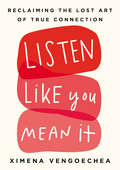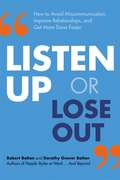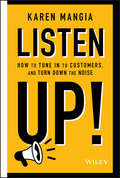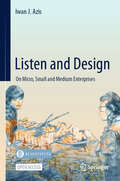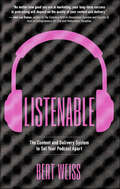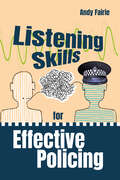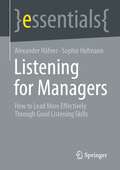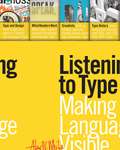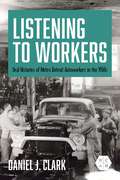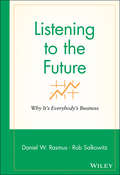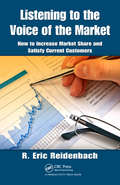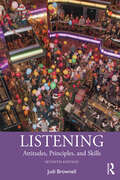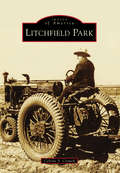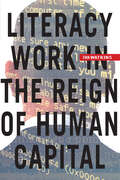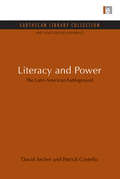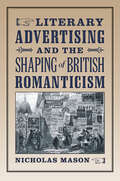- Table View
- List View
Listen Like You Mean It: Reclaiming the Lost Art of True Connection
by Ximena Vengoechea&“Full of revealing, instantly applicable ideas for leveraging your strengths and overcoming your weaknesses.&” —Adam Grant, author of Think Again and Originals, and host of the TED podcast WorkLife For many of us, listening is simply something we do on autopilot. We hear just enough of what others say to get our work done, maintain friendships, and be polite with our neighbors. But we miss crucial opportunities to go deeper—to give and receive honest feedback, to make connections that will endure for the long haul, and to discover who people truly are at their core. Fortunately, listening can be improved—and Ximena Vengoechea can show you how. In Listen Like You Mean It, she offers an essential listening guide for our times, revealing tried-and-true strategies honed in her own research sessions and drawn from interviews with marriage counselors, podcast hosts, life coaches, journalists, filmmakers, and other listening experts. Through Vengoechea&’s set of scripts, key questions, exercises, and illustrations, you&’ll learn to: • Quickly build rapport with strangers • Ask the right questions to deepen a conversation • Pause at the right time to encourage vulnerability • Navigate a conversation that&’s gone off the rails Now more than ever, we need to feel heard, connected, and understood in a world that keeps turning up the volume. Warm, funny, and immensely practical, this book shows you how.
Listen Up or Lose Out: How to Avoid Miscommunication, Improve Relationships, and Get More Done Faster
by Robert Bolton Dorothy Grover BoltonLearning how to actively listen and absorb what a person is saying, thinking, and feeling can set the stage for dramatically improved relationships and increased personal success.Most people retain only a fraction of what they hear, resulting in miscommunications and lost opportunities. In Listen Up or Lose Out, communications expert Robert Bolton highlights the underestimated and under-utilized tool of active listening and explains how it can be used to gather perspectives, bridge differences, and resolve problems.Bolton teaches you key communication skills by:breaking down listening into a set of learnable skills such as avoiding the urge to criticize, question, or advise;focusing on the speaker&’s point of view;asking the right questions, in the right order;and learning how to read people&’s feelings and reflect them back Listen Up or Lose Out explains how one can become a skilled listener who experiences fewer conflicts, makes better decisions, and discovers opportunities that others might miss. Whether personally or in business, could you benefit from better communication? Give listening a try!
Listen Up!: How to Tune In to Customers and Turn Down the Noise
by Karen MangiaThere’s one voice that matters more than any other: the voice of the customer. Learn how to fully understand the number one source of your organization’s prosperity, profits, and productivity. These actionable insights will help you to better connect with your customers and gain an undeniable lead over your competition. Listen Up!: How to Tune In to Customers and Turn Down the Noise teaches readers how to create a customer experience that’s built on listening and designed for engagement. Author and Salesforce executive Karen Mangia has created a practical and comprehensive examination of how best-of-breed companies listen and respond to customer demands—creating a foundation of customer success, loyalty, and brand evolution. Listen Up! features discussions about: How to go beyond the survey: best practices associated with customer understanding, customer experience, and customer service How to move from deep listening to data-based insights into customer behavior The statistics and stories behind companies, organizations, and even city governments that have created a customer-centric culture How powerful new questions can offer a fresh perspective into any customer, anywhere: empowering your customer-facing teams, including sales teams, in the current market Winning greater mindshare, and market share, with a fresh look at the future of customer service, customer success, and customer satisfaction Perfect for anyone in a leadership or management role in a customer-facing organization, including sales teams, business development leaders and marketing professionals, Listen Up! belongs on the bookshelves of executives, customer service and success employees, and leaders who want to better engage with the one voice that matters most: the voice of the customer.
Listen and Design: On Micro, Small and Medium Enterprises
by Iwan J. AzisThis open access book thoroughly investigates the domain of policy design tailored specifically for micro, small, and medium enterprises (MSMEs) with a central emphasis on harmonizing these policies with the preexisting social capital inherent to these enterprises, consistent with the mandate of Bank Indonesia to guard price stability and to promote financial stability, inclusive, and sustainable growth. The study, grounded in the context of Indonesia, underscores the paramount importance of a systematic approach, necessitating social planners and stakeholders to engage in a preliminary phase of active listening, empathetic understanding, and comprehensive knowledge of the diverse mental frameworks prevalent among MSMEs across the nation before embarking on the formulation of bespoke interventions. Readers of this scholarly work can anticipate gaining insightful perspectives into the nuanced policy preferences of both MSMEs and government officials. The methodologies employed, including the Analytic Hierarchy Process and Analytic Network Process, are not only presented but also subjected to rigorous feasibility assessments using the Mechanism Design Theory. Furthermore, the book delves into the intricate challenges faced by MSMEs, including addressing the financing gap and adapting to the digitalization landscape that considers the prevailing social capital, both of which significantly influence their overall productivity. Ultimately, the study underscores the pivotal role played by networks, rather than mere size and the usual suspects (financing, technology, and management), as the linchpin of social capital that profoundly shapes the performance of MSMEs within a specific socio-economic context.
Listenable: The Content and Delivery System to Set Your Podcast Apart
by Bert WeissThere is great news and bad news when it comes to podcasting.The great news? Anybody can start a podcast. The bad news? Anybody can start a podcast. And it seems as if everyone is starting a podcast.A simple Google search reveals countless guides about how to start a podcast. From equipment to software, someone can go live with a new podcast in a matter of days with simple step-by-step instructions about recording and launching their show.But what’s lacking is simple and effective training on how to create a podcast that’s actually listenable—that makes listeners hit that subscribe button. In Listenable, syndicated morning-drive radio host, Bert Weiss, shares a simple content and delivery strategy anyone can use to produce a show that builds a large, loyal audience.
Listening Skills for Effective Policing
by Andy FairieDeveloping and honing effective listening skills for trainee, new and existing police officers at all levels.Learning how to be an effective listener is one of the most vital communication skills for successful policing. Drawing on the author’s vast experience as a specialist frontline police officer, this book is informal and easy-to-understand, with a sprinkle of humour, making it highly readable and accessible. It introduces an effective, tried and tested model to guide difficult conversations and covers a range of key topics of relevance to operational policing, including issues connected with diversity and with suicide. Supported by academic research, including counselling theory, it provides real-life examples to demonstrate how the tools work in practice, and questions and exercises to encourage personal reflection.
Listening for Managers: How to Lead More Effectively Through Good Listening Skills (essentials)
by Alexander Häfner Sophie HofmannManagers who listen well thus create trusting relationships with their employees. They promote job satisfaction, employee loyalty and performance. Good listening reduces the risk of burnout. The book provides tips for managers to improve their listening skills and thus lead more effectively.Unfortunately, self-perception and the image of others often diverge greatly: those who believe themselves to be good listeners are often perceived quite differently by others. This makes critical self-reflection, external feedback and practice all the more important. The book provides a variety of suggestions for this.
Listening to Type: Making Language Visible
by Alex W. WhiteWith this visually stunning primer, designers will develop the skills and vision to produce truly innovative, eye-catching type design. All the basics of type design are covered, and in-depth information is provided on more advanced topics such as the differences between type applications, how typography creates identity, and what best inspires readers. Chapters cover:The language of typeSpace and typeTypographic unityWhat makes readers respondType and identityEvolving type treatmentsReadability and legibilityA timeline of the evolution of writing and typographyDesigner Alex W. White packs the pages with fifteen hundred images-modern and ancient, specially created and found-that illustrate typographic concepts and continue to yield more complexity and connectivity with each viewing. Listening to Type proves that type is much more than groups of letterforms on a page; it is a language with the ability to convey meaning and evoke emotions beyond the spoken words it symbolizes.Allworth Press, an imprint of Skyhorse Publishing, publishes a broad range of books on the visual and performing arts, with emphasis on the business of art. Our titles cover subjects such as graphic design, theater, branding, fine art, photography, interior design, writing, acting, film, how to start careers, business and legal forms, business practices, and more. While we don't aspire to publish a New York Times bestseller or a national bestseller, we are deeply committed to quality books that help creative professionals succeed and thrive. We often publish in areas overlooked by other publishers and welcome the author whose expertise can help our audience of readers.
Listening to Workers: Oral Histories of Metro Detroit Autoworkers in the 1950s (Working Class in American History)
by Daniel J. ClarkHistorians and readers alike often overlook the everyday experiences of workers. Drawing on years of interviews and archival research, Daniel J. Clark presents the rich, interesting, and sometimes confounding lives of men and women who worked in Detroit-area automotive plants in the 1950s. In their own words, the interviewees frankly discuss personal matters like divorce and poverty alongside recollections of childhood and first jobs, marriage and working women, church and hobbies, and support systems and workplace dangers. Their frequent struggles with unstable jobs and economic insecurity upend notions of the 1950s as a golden age of prosperity while stories of domestic violence and infidelity open a door to intimate aspects of their lives. Taken together, the narratives offer seldom-seen accounts of autoworkers as complex and multidimensional human beings. Compelling and surprising, Listening to Workers foregoes the union-focused strain of labor history to provide ground-level snapshots of a blue-collar world.
Listening to the Future: Why It's Everybody's Business (Microsoft Executive Leadership Series #18)
by Rob Salkowitz Daniel W. RasmusListening to the Future: Why It's Everybody's Business explores the challenges and opportunities facing organizations, the transformations that will ripple through the political, economic, and social environments, and the implications for different industries in the 21st century workplace. Written by Microsoft forecasters Daniel W. Rasmus and Rob Salkowitz, this important book equips your business to get out in front of new technology innovations in the consumer world with the knowledge, practices, and tools to differentiate your business in our competitive, fast-moving global economy.
Listening to the Groundswell: Using Social Technologies to Gather Information and Monitor Your Brand
by Charlene Li Josh BernoffMarketers tell us they define and manage brands-they own it. Bull. Your brand is whatever your customers say it is. And in the groundswell, where customers communicate with each other through social technologies rather than relying on institutions (like yours), they decide what your brand represents. So you have to learn what your customers want by listening. In this chapter, social media strategy leaders Charlene Li and Josh Bernoff explain how to use the groundswell for research purposes, with tools like private communities and brand monitoring. Case studies from the National Comprehensive Cancer Network and the car company Mini demonstrate this capability in action. The chapter concludes with a list of practical suggestions that will help you succeed as you begin listening to the groundswell. This chapter was originally published as Chapter 5 of "Groundswell, Expanded and Revised Edition: Winning in a World Transformed by Social Technologies."
Listening to the Music Beneath the Words: Teaching Adaptive Leadership
by Sharon D. ParksThe conventional assumption about great leadership is that leadership charisma is something one must be born with. However, this chapter describes how the case-in-point approach offers pathways for developing the more valuable quality of presence--the ability to intervene, to hold steady, inspire a group, and work in both verbal and nonverbal realms.
Listening to the Voice of the Market: How to Increase Market Share and Satisfy Current Customers
by R. Eric ReidenbachTypically, when companies want to improve their products, they go to their customers. But why not reach further and explore the entire market? In this eye-opening book, Eric Reidenbach goes beyond the "voice of the customer" that so many consultants talk about to introduce you to a groundbreaking concept: the Voice of the Market. Like most business
Listening: Attitudes, Principles, and Skills
by Judi BrownellThis fully updated seventh edition takes an experiential approach to listening instruction, providing extensive applied examples and cases within the context of the HURIER listening model. This textbook encourages students to view listening as a process involving six interrelated components which are developed along the parallel dimensions of theory and skill building. This new edition includes additional and updated cases, exercises, and questions for discussion to address students’ world of evolving technology, expanding social boundaries, and global communication challenges. A new challenge, integrative listening, addresses students’ social responsibility as effective listeners and suggests that they apply their skills to create strong listening environments characterized by respectful and inclusive dialogue. Students move from self-reflection and self-knowledge through skill development and personal applications to creating listening environments that facilitate productive conversation and collaboration. Cases in “the bigger picture” address issues such as the opioid crisis, fake news, artificial intelligence, and teenagers’ mental health. Listening serves as a core textbook for courses in listening, communication studies, communication skills, interpersonal communication, management, human resources, and education.
Listening: Attitudes, Principles, and Skills
by Judi BrownellProvides an applied, experiential approach to listening instruction with special attention to interpersonal, family, professional, educational, and health contexts Market leading text for Listening courses in Communication, with additional application for management, education, and human resources courses Text contains practical features including case studies, exercises, discussion questions, and journal assignments --Online resources include PowerPoint slides and exercises
Listening: Finding and Attracting Key Interpreters--Design-Driven Innovation Requires a Community of "Designers"
by Roberto VergantiThere are some detractors who have mistakenly interpreted the design-driven approach to innovation as too heavily reliant on the vision of a single superstar designer. The success of design-driven innovation, however, depends on your firm's ability to engage in a larger design discourse and to draw on the work of many researchers, sometimes from widely varying backgrounds. In this chapter, noted innovation expert Roberto Verganti analyzes how firms implementing design-driven innovation build this important dialogue by effectively tapping into multiple sources of insight into product meanings. He provides guidelines that will enable managers to assemble a unique circle of interlocutors that may become an invaluable wellspring of innovation. This chapter was originally published as chapter 7 of "Design-Driven Innovation: Changing the Rules of Competition by Radically Innovating What Things Mean."
Listeria monocytogenes in the Food Processing Environment
by Kieran Jordan Dara Leong Avelino Álvarez OrdóñezThis Brief focuses on Listeria monocytogenes, from isolation methods and characterization (including whole genome sequencing), to manipulation and control. Listeriosis, a foodborne disease caused by Listeria monocytogenes is a major concern for public health authorities. In addition, addressing issues relating to L. monocytogenes is a major economic burden on industry. Awareness of its ubiquitous nature and understanding its physiology and survival are important aspects of its control in the food processing environment and the reduction of the public health concern.
Liston Mechanics Corp.
by Marc L. BertonecheReviews, through a rather simple and straightforward situation, the various methods of valuation--free cash flow, weighted average cost of capital, equity cash flow, adjusted present value, multiples, etc.
Lit Motors
by Thomas R. Eisenmann Alex GoddenIn mid-2012 Lit Motors had created both engineering and design prototypes and conducted initial customer tests on less than $750,000 of investment. Lit Motors' founder, Daniel Kim had started the company to design and manufacture an efficient electric 2-wheeled vehicle. The company had refined the designs for the key technologies required and had a working prototype, an understanding of the manufacturing processes to be used and a list of the components required. They also had a design prototype that they had used to conduct customer tests and establish reactions to pricing levels. At this point, management was aiming to raise $15M to get closer to manufacturing prototypes, but had they sufficiently proved out both the manufacturing feasibility and the market demand? How could they address the next hurdles in terms of partnership building, supply chain management and go-to-market strategy?
Lit and Dark Liquidity with Lost Time Data: Interlinked Trading Venues around the Global Financial Crisis
by Tommi A. VuorenmaaIn Measuring Liquidity and Lost Time Data, Vuorenmaa analyses liquidity to better understand the crux of the financial crisis.
Litchfield Park
by Celeste S. CrouchIn 1908, William Kriegbaum, a California citrus grower, arrived as the first settler in what was to become Litchfield Park. He, along with other settlers from California, owned the land until 1916, when Paul Litchfield of Goodyear Tire & Rubber Company came to the area and purchased 16,000 acres to plant cotton for tires. In 1918, the townsite was planned with tree-lined streets and buildings to include an "organizational house" for Goodyear executives, which is now the famed Wigwam Resort. When new materials for tires were developed, cotton was no longer needed for cord. Shortly thereafter, Goodyear brought its tire-testing fleet to Litchfield, and farm equipment companies followed suit, sending engineers to design and test new machinery. The steel-wheeled tractor tire was replaced by Paul Litchfield's newly patented pneumatic tire as the standard for farm equipment. The World War II years brought changes to the area as an influx of new residents transformed the company town to a more planned community.
Lite Up Your Work and Life: 6 Essentials to Expressing Your Full Potential
by Helen RoditisARE YOU YEARNING TO EXPRESS YOUR FULL POTENTIAL? Helen Roditis has experienced what many employees and business owners experience daily: pressure to keep it together while striving to thrive. To revitalize her life and the lives of others, she became a holistic leadership coach. After coaching hundreds of clients, she noticed that many are hungry for growth, meaning, and balance, and a work environment that supports their development. No matter what issues her clients brought to coaching, their deeper yearning to live out their full potential was the same. In response to this need, Helen developed an integrated coaching model to help her clients identify and live out their full potential in work and life. LITE Up Your Work and Life offers this same holistic coaching model to you. Whether you're contemplating a new career, experiencing a major transition, or simply longing for more fulfillment, these 6 essentials will help you discover your core purpose, integrate your work and life with vibrant synergy, and find peace in the fulfillment that comes from living out your full potential. INSIDE YOU WILL FIND: -The Circle of LITE, a holistic coaching model designed to help bring out your full potential step by step; Exercises that will awaken your inner power to lead a purposeful career and life that reflects who you are; How, through a twist of fate, Helen overcame her own self-limiting beliefs and began expressing her essence; and more. Helen Roditis, an Associate Certified Coach, International Coach Federation member, and founder of essence coaching, brings over 20 years of professional and personal experience to her work. Her articles Empower Your Employees and Reap the Rewards, and Proactively Managing Employee Stress have been published in Canadian business magazines. Connect with Helen at www.helenroditis.com.
Literacy Work in the Reign of Human Capital
by Evan WatkinsIn recent years, a number of books in the field of literacy research have addressed the experiences of literacy users or the multiple processes of learning literacy skills in a rapidly changing technological environment. In contrast to these studies, this book addresses the subjects of literacy. In other words, it is about how literacy workers are subjected to the relations between new forms of labor and the concept of human capital as a dominant economic structure in the United States. It is about how literacies become forms of value producing labor in everyday life both within and beyond the workplace itself.As Evan Watkins shows, apprehending the meaning of literacy work requires an understanding of how literacies have changed in relation to not only technology but also to labor, capital, and economics. The emergence of new literacies has produced considerable debate over basic definitions as well as the complexities of gain and loss. At the same time, the visibility of these debates between advocates of old versus new literacies has obscured the development of more fundamental changes. Most significantly, Watkins argues, it is no longer possible to represent human capital solely as the kind of long-term resource that Gary Becker and other neoclassical economists have defined. Like corporate inventory and business management practices, human capital—labor—now also appears in a “just-in-time” form, as if a power of action on the occasion rather than a capital asset in reserve.Just-in-time human capital valorizes the expansion of choice, but it depends absolutely on the invisible literacy work consigned to the peripheries of concentrated human capital. In an economy wherein peoples’ attention begins to eclipse information as a primary commodity, a small number of choices appear with an immensely magnified intensity while most others disappear entirely. As Literacy Work in the Reign of Human Capital deftly illustrates, the concentration of human labor in the digital age reinforces and extends a class division of winners on the inside of technological innovation and losers everywhere else.
Literacy and Power: The Latin American battleground (Aid and Development Set)
by David Archer Patrick CostelloThe often bloody struggles of Central America have dominated news reports for a long time. Behind the headlines lies an enormous population of the desperately poor, and it is axiomatic that they are rendered even more powerless by widespread illiteracy. What actually counts as literacy is less clear. Archer and Costello describe some of the most exciting and innovative programmes designed to overcome the problem and how, as they worked with many of them, they discovered how varied and controversial they are. El Salvador, Nicaragua, Honduras, Ecuador, Mexico, Chile, Bolivia and Guatemala are all included, and for each country the authors have provided a thrilling account of the lives and circumstances of the people who both teach and learn as well as describing the varied forms that literacy teaching, even literacy itself, can take. This book is not only about literacy, but is also a guide to the societies of one of the world's most troubled regions. Originally published in 1990
Literary Advertising and the Shaping of British Romanticism
by Nicholas MasonImportant revisions to the history of advertising and its connection to Romantic-era literature.Outstanding Academic Title, ChoiceLiterary Advertising and the Shaping of British Romanticism investigates the entwined histories of the advertising industry and the gradual commodification of literature over the course of the Romantic Century (1750–1850). In this engaging and detailed study, Nicholas Mason argues that the seemingly antagonistic arenas of marketing and literature share a common genealogy and, in many instances, even a symbiotic relationship. Drawing from archival materials such as publishers' account books, merchants' trade cards, and authors' letters, Mason traces the beginnings of many familiar modern advertising methods—including product placement, limited-time offers, and journalistic puffery—to the British book trade during the eighteenth and nineteenth centuries. Until now, Romantic scholars have not fully recognized advertising’s cultural significance or the importance of this period in the origins of modern advertising. Mason explores Lord Byron’s appropriation of branding, Letitia Elizabeth Landon’s experiments in visual marketing, and late-Romantic debates over advertising's claim to be a new branch of the literary arts. Mason uses the antics of Romantic-era advertising to illustrate the profound implications of commercial modernity, both in economic practices governing the book trade and, more broadly, in the development of the modern idea of literature.
